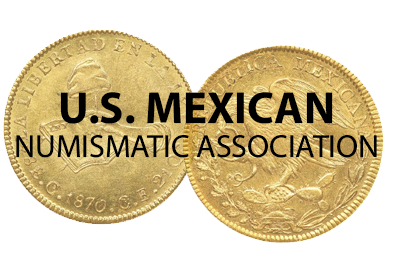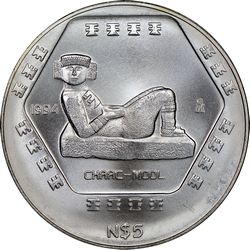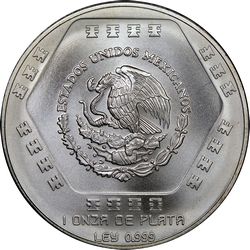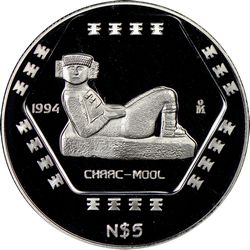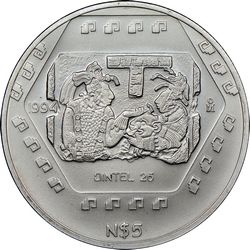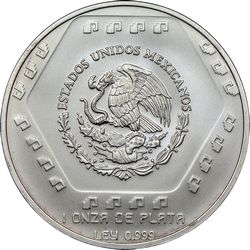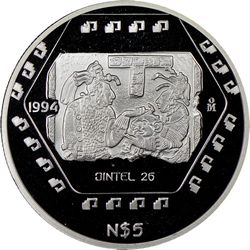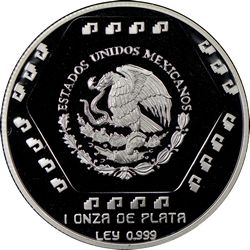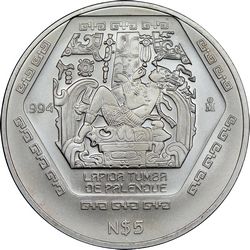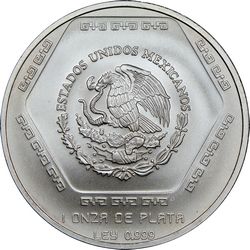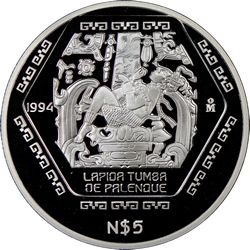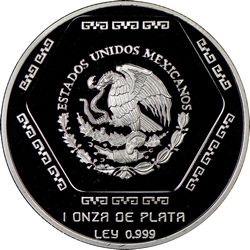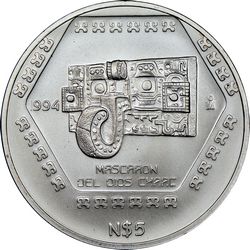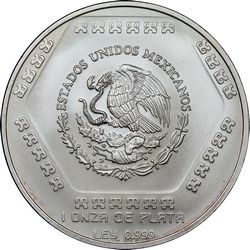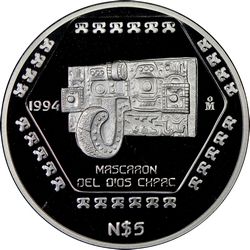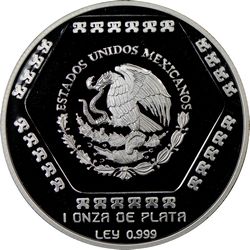Pre-Columbian Series – Mayan Collection – Silver 1 Oz. (Uncirculated & Proof)
by Alberto Rodriguez
Introduction
This third article of this multi-part series, on the Pre-Columbian series for 1 ounce silver coins, will cover the Mayan collection. If you missed the first and second articles from the June and September 2024 editions of this journal, I encourage you to read those first, where a more thorough introduction was presented. These articles look to share the storytelling of this series first introduced to me by the late Don Bailey’s Whitman Encyclopedia of Mexican Money Volume 2. In addition, these articles seek to provide clarity into the multiple varieties of the coins in the series and distill the ambiguity surrounding mintages for this series.
In the first article, I shared how I first got into collecting Mexican numismatics, and in particular, the Libertad series. Since then something exciting has taken place that I think will be pivotal in welcoming many new collectors to the world of Mexican numismatics. In July 2024, Whitman finally decided to print and release more copies of Bailey’s aforementioned Volume 2 book. I was overcome with nostalgia, as this book had a very limited first printing, and I forced to buy a used copy in May of 2022 for a very steep markup off eBay. This book has been special to me and served as a nexus between collecting only Libertads to collecting various other Mexican numismatics.
Bailey’s book goes beyond making a focused effort to catalogue Mexican coins. Bailey and those who helped him tell the stories within the book have done something special. Like skilled raconteurs, the book curates and combines coins and their features with a rich historical context from the era of the coins. I personally had nothing more than a pedestrian knowledge of Mexican culture until the day I obtained that book. When you read and immerse yourself in the stories about the Pre-Columbian series you cannot help but to feel like you have a museum in your hands with a coin in one hand and a history book in the other.
Key Highlights
Before immersing ourselves into discussion about each coin, it is worth highlighting two factors that have obscured collectors’ understanding of mintages for this particular series. As highlighted in earlier articles, both online coin directories and authoritative catalogs only publish the original mintages from when the coins were first released, but leave out published restrikes, by the Banco de México. The Pre-Columbian series, in fact, minted additional strikes from the years 2000 – 2011. Another factor to take into consideration is what I have termed the Melted Factor. Anecdotally several folks in the business, both in Mexico and the United States, have suggested that during the parabolic silver price run up of 2010-2011, 35%-50% of silver Pre Columbians had been melted. Further evidence from Mexican coin collectors and old online message board posts suggests this series was long treated like bullion and has long sold for spot. Many of the surviving pieces also have evidence of acid tests on the surface. Taking this Melted Factor into consideration provides a more accurate representation of available mintage today. Since the publication of the first two articles, it has been brought to my attention by readers of this journal, that Proof coins have always commanded a market premium versus their Brilliant Uncirculated counterparts and as such, the melted factor on Proofs is likely to be close to the lower bound of 35%.
The Mayan Collection
The third collection in the series honors the Mayan culture, one of the oldest of the Mesoamerican civilizations. Mayan history dates from circa 1800 BC, with the most prosperous period beginning around 250 AD. The Maya occupied areas in modern day southeast Mexico, specifically the Yucatán Peninsula, Guatemala, Belize, El Salvador, and Honduras. The most prominent groups were the Yucatec and the K’iche’. Dispersed over a wide territory, the Maya are represented by multiple city-states including Tikal, Chichén Itzá and Palenque, in contrast to a single large city like Tenochtitlán. Within the cities, but also between a few of them, the Maya constructed sacbeob, or “white ways”, in particular described as paved roads coated with limestone stucco. The most famous sacbeob are found in Yucatán, but many survive in other Mayan areas as well.
The Maya placed their decorative stone temples atop huge, step-sided pyramids. El Castillo, located in Chichén Itzá, is the most widely recognized of these. The interiors of the temples were decorated with intricate murals and hieroglyphics, and in fact the Maya are noted for having the most fully developed written language known in the Pre-Columbian Americas. They were also advanced in their studies of mathematics and astronomy and are particularly known for their sophisticated calendrical system.
The Mayan economy was largely agricultural, and evidence of their advances in this area can still be seen today, most notably in raised fields that were built in the swamps and flood plains. The society was hierarchical, with royalty at the top, followed by commoners, servants, and slaves. Only the nobility was allowed to serve as priests, who were responsible for ritual observances and maintaining the calendar, among other duties. Like other Mesoamerican religions, Mayan rituals included human sacrifice, using methods of decapitation, heart removal, and disembowelment, which were depicted in their artwork.
When the Spanish arrived in the 16th century, the widespread Maya proved difficult to overthrow. In 1524, during the Spanish conquest of Guatemala, the K’iche’ Maya were ultimately defeated by the conquistador Pedro de Alvarado and his forces. The Yucatec Maya were defeated by Francisco de Montejo some 20 years later. The resilient Maya endured, and their descendants still reside in the Yucatán Peninsula and Guatemala.
Chaac-Mool
The Chaac-Mool sacrificial altar from Chichén Itzá is thought to have been associated with Mayan sacrificial rituals. The design, based on one such figure held in the National Museum of Anthropology, depicts a semi reclining male figure. His knees are bent, his feet and elbows are on the ground, and his hands hold a tray or plate on his abdomen. His face is turned sharply to look over one shoulder. The border design is inspired by Mayan glyphs.
The 1-ounce silver Chaac-Mool design was issued in 1994. The design was issued in the new 5 pesos denomination in both Brilliant Uncirculated and Proof. Both formats were struck in a single variety.
Chaac-Mool – Brilliant Uncirculated (BU) Variety Overview
The Brilliant Uncirculated coin has a reverse with a Chaac-Mool figure at the center of the field with the date to the left, the mintmark to the right (MMR), and CHAAC-MOOL in the exergue below. An ornamental border surrounds the hexagonal field, crossing into the inside of the field on the uppermost sixth side, with the N$5 below the border on the bottom side.
The obverse of the coin displays the national coat of arms with the eagle facing left with its feathers resembling plates of armor on the center of the field. Above it, the legend ESTADOS UNIDOS MEXICANOS, and below it, a half-wreath of oak and laurel. Surrounding the field is the ornamental border discussed above. Below the border is displayed 1 ONZA DE PLATA, and further below LEY 0.999
$5 New Pesos (MMR) Raised Denomination
There were 208,300 original strikes for the 1994 1oz silver Chaac-Mool coin. After having gone through repeated iterations of making comparisons, this coin offers another unique instance where the Standard Catalog of World Coins and Whitman Encyclopedia of Mexican Money agree on the original mintage for this coin. Conversely, Numista looks to be the outlier, indicating only a mintage of 50,000.
The additional strikes from the years 2000 – 2011 are published on the Banco de México’s website. Luckily we are not faced with the challenge of addressing varieties for this coin. The total additional strikes are 1,300. With the additional strikes in subsequent years, the grand total combined for this coin is 209,600.
Applying the Melted Factor, discussed in the earlier key highlights, of 35-50%, leaves us with an estimated survival mintage of 104,800 - 136,240. Collating all the aforementioned figures results in the following table:
| 1oz Silver MS Pre-Columbian Series - Chaac Mool | |||||
| Original Mintage | Restrikes | Total Including Restrikes | Estimated Minimum Surviving | Estimated Maximum Surviving | |
| 1994 5 Pesos MMR | 208,300 | 1,300 | 209,600 | 104,800 | 136,240 |
Chaac-Mool – Proof Variety Overview
The 1oz Chaac-Mool silver Proof shares the same coin elements as its Brilliant Uncirculated counterpart but is further distinguished by a mirrored inner field and border area on both sides with a raised and frosted denomination on the reverse as well as a raised and frosted legend on the obverse.
We again encounter an agreement between the Standard Catalog of World Coins and Whitman Encyclopedia of Mexican Money on the original mintage for this coin with 6,700. And again, Numista looks to be the outlier, indicating only a mintage of 3,000.
The additional strikes from the years 2000 – 2011 published on the Banco de México’s website amount to 2,100. With the additional strikes in subsequent years, the grand total combined is 8,800.
$5 New Pesos (MMR) Raised Denomination
Applying the Melted Factor of 35-50%, leaves us with an estimated survival mintage of 4,400 – 5,720. The figures gathered above result in the following table:
| 1oz Silver PF Pre-Columbian Series - Chaac Mool | |||||
| Original Mintage | Restrikes | Total Including Restrikes | Estimated Minimum Surviving | Estimated Maximum Surviving | |
| 1994 5 Pesos MMR | 6,700 | 2,100 | 8,800 | 4,400 | 5,720 |
Dintel 26
The ruins of the ancient Mayan city Yaxchilán, in what is now the state of Chiapas, are famous for the sculpted lintels above the doorways. Archaeologists describe these important sculptures by number. The Mexican mint chose Dintel (Lintel) 26, now held in the National Museum of Anthropology, as the subject of this 1oz coin. The sculpture, which dates to about 726 A.D., depicts a ritual scene in which a woman gives the head or possibly a mask of a jaguar to a dignitary or high priest. The coin’s border design is inspired by Mayan glyphs. The design was issued in a single variety in the new 5 pesos denomination in both Brilliant Uncirculated and Proof dated 1994.
Dintel 26 – Brilliant Uncirculated (BU) Variety Overview
The Uncirculated coin has a reverse with a centered image of the upper half from the sculpted Dintel 26, with the date 1994 to the left and the mintmark to right (MMR). DINTEL 26 is displayed on the exergue below. An ornamental border surrounds the hexagonal field, crossing into the inside of the field on the uppermost sixth side, with the N$5 below the border on the bottom side. The obverse is identical to its Mayan collection counterparts, with the exception of the coin border, in which the patterns are unique to each coin in the collection.
The Standard Catalog of World Coins and Whitman Encyclopedia of Mexican Money both have a original mintage for this coin of 4,080. Now while Numista continues to have divergent mintage figures for the coins of the Mayan collection, in the case of Dintel 26, that figure is rather close to the aforementioned, coming in at 4,500. The additional strikes from the years 2000 – 2011 published on the Banco de Méxicos website amount to 3,800. The grand total combined original mintage plus restrikes is then 7,880.
$5 New Pesos (MMR) Raised Denomination
Applying the Melted Factor of 35-50% leaves us with an estimated survival mintage of 3,940-5,122. A summary of these figures is shown as follows:
| 1oz Silver MS Pre-Columbian Series - Dintel 26 | |||||
| Original Mintage | Restrikes | Total Including Restrikes | Estimated Minimum Surviving | Estimated Maximum Surviving | |
| 1994 5 Pesos MMR | 4,080 | 3,800 | 7,880 | 3,940 | 5,122 |
Dintel 26 – Proof Variety Overview
The Proof variety shares the same coin elements as its Brilliant Uncirculated counterpart but is further distinguished by a mirrored inner field and border area on both sides with a raised and frosted denomination on the reverse as well as a raised and frosted legend on the obverse.
Both the Standard Catalog of World Coins and Whitman Encyclopedia of Mexican Money have an original mintage for this coin of 6,000. Numista once again features a peculiar mintage figure of 2,600.
The additional strikes from the years 2000 – 2011 published on the Banco de México’s website total 2,500. With these additional strikes in subsequent years, the grand total combined is 8,500.
$5 New Pesos (MMR)
Raised Denomination
Applying the Melted Factor of 35-50%, leaves us with an estimated survival mintage of 4,250-5,525. The figures gathered above are shown in the following table:
| 1oz Silver PF Pre-Columbian Series - Carita Dintel 26 | |||||
| Original Mintage | Restrikes | Total Including Restrikes | Estimated Minimum Surviving | Estimated Maximum Surviving | |
| 1994 5 Pesos MMR | 6,000 | 2,500 | 8,500 | 4,250 | 5,525 |
Lapida Tumba de Palenque
This 1 oz silver coin’s design, Lápida Tumba de Palenque (Gravestone of a Palenque Tomb), is taken from the bas-relief slab that covered the sarcophagus of the Mayan ruler Pakal in the ancient city of Palenque. The central figure of the design is the body of Pakal himself, who lies atop the monster of the sun at the base of the Tree of the World, as he prepares to journey to the afterlife.
Incidentally, those of us of a certain age might remember that this image was a central tenet in Erich von Däniken’s crackpot theory that the technologies and religions of many ancient civilizations were given to them by ancient astronauts who were welcomed as gods. In Chariots of the Gods? Unsolved Mysteries of the Past von Däniken argued that this figure depicts an astronaut, wearing appropriate clothing and a complicated space helmet, at the controls of his rocket, Not shown on the coin but on the original tombstone, below the ‘astronaut’ is a Tree of the World or, for von Dåniken, “strangely grooved indentations like inlet ports, that widen out and terminate at the tail in a darting flame”. The coin’s border design is inspired by Mayan glyphs.
This coin was issued in 1994 in Brilliant Uncirculated and Proof.
Lápida Tumba de Palenque – Brilliant Uncirculated (BU) Variety Overview
The Uncirculated coin has a reverse with an ornamental segment of Pakal’s tomb at the center of the field, the date to the left and the mintmark to the right (MMR). The exergue LAPIDA TUMBA DE PALENQUE is found below. An ornamental border surrounds the hexagonal field, crossing into the inside of the field on the uppermost sixth side, with the N$5 below the border on the bottom side. The obverse is identical to its Mayan collection counterparts, with the exception of the coin border, in which the patterns are unique to each coin in the collection.
$5 New Pesos (MMR) Raised Denomination
Both the Standard Catalog and Whitman Encyclopedia have an original mintage for this coin of 5,905. Numista’s conflicting mintage figure comes in at 4,500. The additional strikes from the years 2000 – 2011 published on the Banco de México’s website amount to 3,800. The grand total combined original mintage plus restrikes is then 9,705.
Applying the Melted Factor of 35-50%, leaves us with an estimated survival mintage of 4,853-6,308.
| 1oz Silver MS Pre-Columbian Series - Lápida Tumba de Palenque | |||||
| Original Mintage | Restrikes | Total Including Restrikes | Estimated Minimum Surviving | Estimated Maximum Surviving | |
| 1994 5 Pesos MMR | 5,905 | 3,800 | 9,705 | 4,853 | 6,308 |
Lápida Tumba de Palenque – Proof Variety Overview
The Proof variety shares the same coin elements as its Brilliant Uncirculated counterpart but again is further distinguished by a mirrored inner field and border area on both sides with a raised and frosted denomination on the reverse as well as a raised and frosted legend on the obverse.
Both the Standard Catalog and Whitman Encyclopedia have an original mintage for this coin of 6,300. Numista’s mintage figure comes in at an anemic 2,800. The additional strikes from the years 2000 – 2011 amount to 2,800. The grand total combined original mintage plus restrikes is then 9,100.
$5 New Pesos (MMR) Raised Denomination
Applying the Melted Factor of 35-50% leaves us with an estimated survival mintage of 4,550-5,915. The figures gathered above are shown in the following table:
| 1oz Silver PF Pre-Columbian Series - Lápida Tumba de Palenque | |||||
| Original Mintage | Restrikes | Total Including Restrikes | Estimated Minimum Surviving | Estimated Maximum Surviving | |
| 1994 5 Pesos MMR | 6,300 | 2,800 | 9,100 | 4,550 | 5,915 |
Mascarón del Dios Chaac
This coin’s design depicts the Mascarón del Dios Chaac, specifically the Mask of the God Chaac, the Mayan rain god. It is found on the façade of the Temple of Kabah in the Yucatán peninsula. The Mayan people made this their most highlighted decorative element. It is featured and repeated by the hundreds on the walls of the temple, which is also known as the Temple of the Masks. The coin’s border design is inspired by Mayan glyphs. The silver 1 oz. coins in this design, denominated 5 new pesos, were issued in 1994 in Brilliant Uncirculated and Proof.
Mascarón del Dios Chaac – Brilliant Uncirculated (BU) Variety Overview
The Brilliant Uncirculated coin has a reverse with a mask of the god Chaac at the center of the field, with the date to the left and the mintmark to right (MMR). MASCARON DEL DIOS CHAAC is displayed on the exergue below. An ornamental border surrounds the hexagonal field, crossing into the inside of the field on the uppermost sixth side, with the N$5 below the border on the bottom side. The obverse is identical to its Mayan collection counterparts, with the exception of the coin border.
$5 New Pesos (MMR) Raised Denomination
The Standard Catalog and Whitman Encyclopedia both have an original mintage for this coin of 3,011. Numista’s mintage figure comes in at 4,500. The additional strikes from the years 2000 – 2011 amount to 3,800. The grand total of combined original mintage plus restrikes is thus 6,811.
Applying the Melted Factor of 35-50%, leaves us with an estimated survival mintage of 3,406-4,427.
| 1oz Silver MS Pre-Columbian Series - Mascarón del Dios Chaac | |||||
| Original Mintage | Restrikes | Total Including Restrikes | Estimated Minimum Surviving | Estimated Maximum Surviving | |
| 19946 5 Pesos MMR | 3,011 | 3,800 | 6,811 | 3,406 | 4.427 |
Mascarón del Dios Chaac – Proof Variety Overview
The Proof variety shares the same coin elements as its Brilliant Uncirculated counterpart but is further distinguished by a mirrored inner field and border area on both sides with a raised and frosted denomination on the reverse as well as a raised and frosted legend on the obverse.
Both the Standard Catalog and Whitman Encyclopedia of Mexican Money have an original mintage for this coin of 6,300. Numista’s conflicting mintage figure comes in at an anemic 2,500. The additional strikes from the years 2000 – 2011 published on the Banco de México’s website amount to 2,300. The grand total combined original mintage plus restrikes is therefore 8,600.
$5 New Pesos (MMR) Raised Denomination
Applying the Melted Factor of 35-50%, leaves us with an estimated survival mintage of 4,300-5,590. The figures gathered above are shown in the following table:
| 1oz Silver PF Pre-Columbian Series - Mascarón del Dios Chaac | |||||
| Original Mintage | Restrikes | Total Including Restrikes | Estimated Minimum Surviving | Estimated Maximum Surviving | |
| 1994 5 Pesos MMR | 6,300 | 2,300 | 8,600 | 4,300 | 5,590 |
Summary
This completes my third article on the Pre-Columbian series for 1 ounce silver coins. It was my intention to continue to provide clarity into the multiple varieties and the ambiguity surrounding mintages for this collection by curating a series of charts that will serve as a more realistic reflection of the available quantities in the market. This by no means is an authoritative guide but does address the deficiencies not addressed in some of the references cited. Three articles remain, honoring the remaining Pre-Columbian civilizations: Olmec, Teotihuacan, and Toltec.
To finish, I would like to recognize Felix Kirzhner for his continued recommendations on various considerations related to the ambiguities discussed in this article. I would also like to acknowledge and recognize Scott Doll whose encouragement inspired me to begin writing and continue to write this series. I would also like to thank him for sharing the coin images shown in this article. I would also like to acknowledge Doug Plasencia at Numismatic Guaranty Company (NGC) for his work on the set of NGC PhotoVision high resolution coin images used in these articles that were shared by Scott.
Please send your comments, questions, or suggestions regarding this article, to me at
References:
Bailey, Don and Lois. Whitman Encyclopedia of Mexican Money, Volume 2: Modern Coins of Mexico, 1905 to Date. Atlanta, GA: Whitman Publishing, LLC, 2015.
Michael, Thomas, Tracy L. Schmidt, and Richard Giedroyc. 2019 Standard Catalog of World Coins. Stevens Point, WI: Krause Publications, 2018.
Numista Mexico Pre-Columbian Mayan Coinage. https://en.numista.com/catalogue/index.php?ct=coin&se=Bullion+Coinage+-+Pre-Columbian+Maya&e=mexique Banco de México Economic Information System (SIE) Coins and Medals – CM27, Annual, Pieces, Flows. https://www.banxico.org.mx/SieInternet/ consultarDirectorioInternetAction.o?sector=11&accion=consultarCuadro&idCuadro=CM27&locale=en
